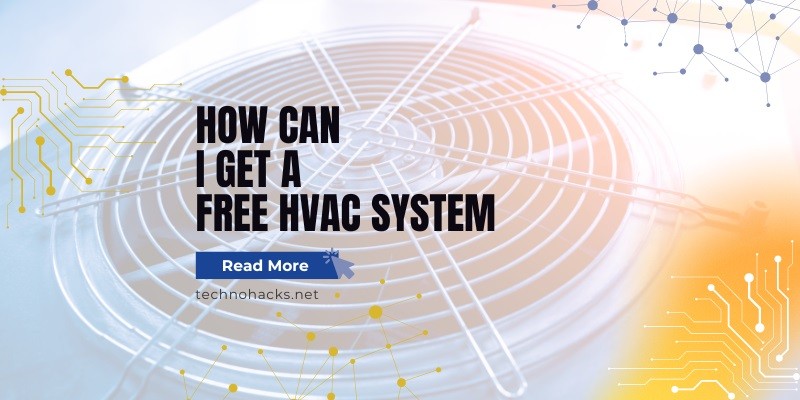Last Updated on May 5, 2025 by Jim C.
Heating, ventilation, and air conditioning (HVAC) systems are essential for maintaining a comfortable indoor environment, but they can be expensive to purchase and install. The average cost of a new HVAC system ranges from $5,000 to $10,000, with some high-efficiency systems costing up to $20,000. For many homeowners, this represents a significant financial burden. However, there are several ways to potentially obtain a free or heavily discounted HVAC system. This article will explore various options and strategies to help you acquire an HVAC system at little to no cost.
Government Assistance Programs
Several government programs offer financial assistance for HVAC upgrades and replacements, particularly for low-income households and energy-efficient systems.
Low Income Home Energy Assistance Program (LIHEAP)
LIHEAP provides federally funded assistance to low-income households for their energy needs, including HVAC system repairs and replacements. Eligibility is typically based on income and household size. While LIHEAP doesn’t always cover the full cost of a new HVAC system, it can significantly reduce out-of-pocket expenses.
Weatherization Assistance Program (WAP)
The WAP is another federal program that helps low-income families improve their home’s energy efficiency. This can include HVAC system upgrades or replacements if deemed necessary during the home energy audit. WAP services are provided at no cost to eligible households.
State and Local Energy Efficiency Programs
Many states and local governments offer their own energy efficiency programs that may include rebates or grants for HVAC upgrades. For example, California offers rebates up to $6,000 for heat pumps and up to $1,000 for energy-efficient air conditioning systems through various programs.
Utility Company Rebates and Incentives
Utility companies often provide rebates and incentives to encourage customers to upgrade to energy-efficient HVAC systems. These can significantly reduce the cost of a new system.
Examples of Utility Rebates
- Pacific Gas and Electric (PG&E): Offers rebates up to $3,000 for high-efficiency heat pumps.
- Duke Energy: Provides rebates up to $525 for central air conditioners and up to $800 for heat pumps.
- Con Edison: Rebates up to $1,000 for energy-efficient HVAC systems, plus additional incentives for smart thermostats.
Nonprofit and Charitable Organizations
Some nonprofit organizations offer assistance with free HVAC replacements, particularly for churches, low-income families, seniors, or veterans. While these programs may be less common, they’re worth exploring in your local community.
Manufacturer Promotions and Giveaways
HVAC manufacturers occasionally run promotions or contests where they give away free systems. While winning such contests is not guaranteed, it’s a potential avenue to explore. Some examples of manufacturer rebates include:
- Carrier: Seasonal promotions with rebates up to $1,650 on qualifying systems.
- Lennox: Rebates up to $1,200 during promotional periods.
- Trane: Offers trade-in allowances and rebates up to $1,000.
Additionally, consider following HVAC companies on social media or subscribing to their newsletters to stay informed about potential giveaways or contests.
Tax Credits and Deductions
The federal government offers tax credits for energy-efficient HVAC systems, which can significantly reduce the overall cost.
Federal Tax Credits
Through 2032, homeowners can claim up to $3,200 annually in federal income tax credits for energy-efficient home upgrades. This includes:
- Up to $2,000 for heat pump installations
- Up to $600 for central air conditioners
- 30% of costs up to $1,200 for other qualified upgrades made in one tax year
State-Specific Tax Incentives
Many states offer additional tax incentives for energy-efficient HVAC upgrades. Research your state’s specific programs to maximize your potential savings.
Alternative Financing Options
While not free, these options can make obtaining a new HVAC system more affordable:
Zero-Interest Financing
Some HVAC companies and manufacturers offer zero-interest financing for a limited time, allowing you to spread the cost over several months or years without accruing interest.
Rent-to-Own or Lease-to-Own Arrangements
These programs allow you to use an HVAC system while making monthly payments, eventually leading to ownership. While not free, they can make the initial cost more manageable.
DIY and Cost-Saving Strategies
While these strategies won’t result in a free HVAC system, they can significantly reduce costs:
Regular Maintenance
Proper maintenance can extend the life of your current HVAC system, potentially delaying the need for a replacement. This includes regular filter changes, annual professional inspections, and prompt repairs of minor issues.
Energy-Saving Tips
Implementing energy-saving measures can reduce the load on your HVAC system, potentially extending its lifespan:
- Improve insulation in your home
- Use programmable or smart thermostats
- Seal air leaks around windows and doors
- Use ceiling fans to improve air circulation
How to Apply for Rebates and Incentives
To maximize your chances of obtaining a free or discounted HVAC system:
- Research available rebates and eligibility requirements through federal, state, and local government websites, as well as your utility company.
- Ensure the HVAC system you’re considering meets specified energy efficiency standards.
- Keep all receipts, certification statements, and required forms.
- Follow the application process outlined by the rebate provider.
- Consider working with a licensed HVAC contractor who can help navigate the rebate application process.
Conclusion
While obtaining a completely free HVAC system may be challenging, there are numerous ways to significantly reduce the cost. By combining government assistance programs, utility rebates, tax credits, and energy-saving strategies, you can make upgrading your HVAC system much more affordable. Remember to thoroughly research all available options in your area and consult with HVAC professionals to find the best solution for your home and budget.

